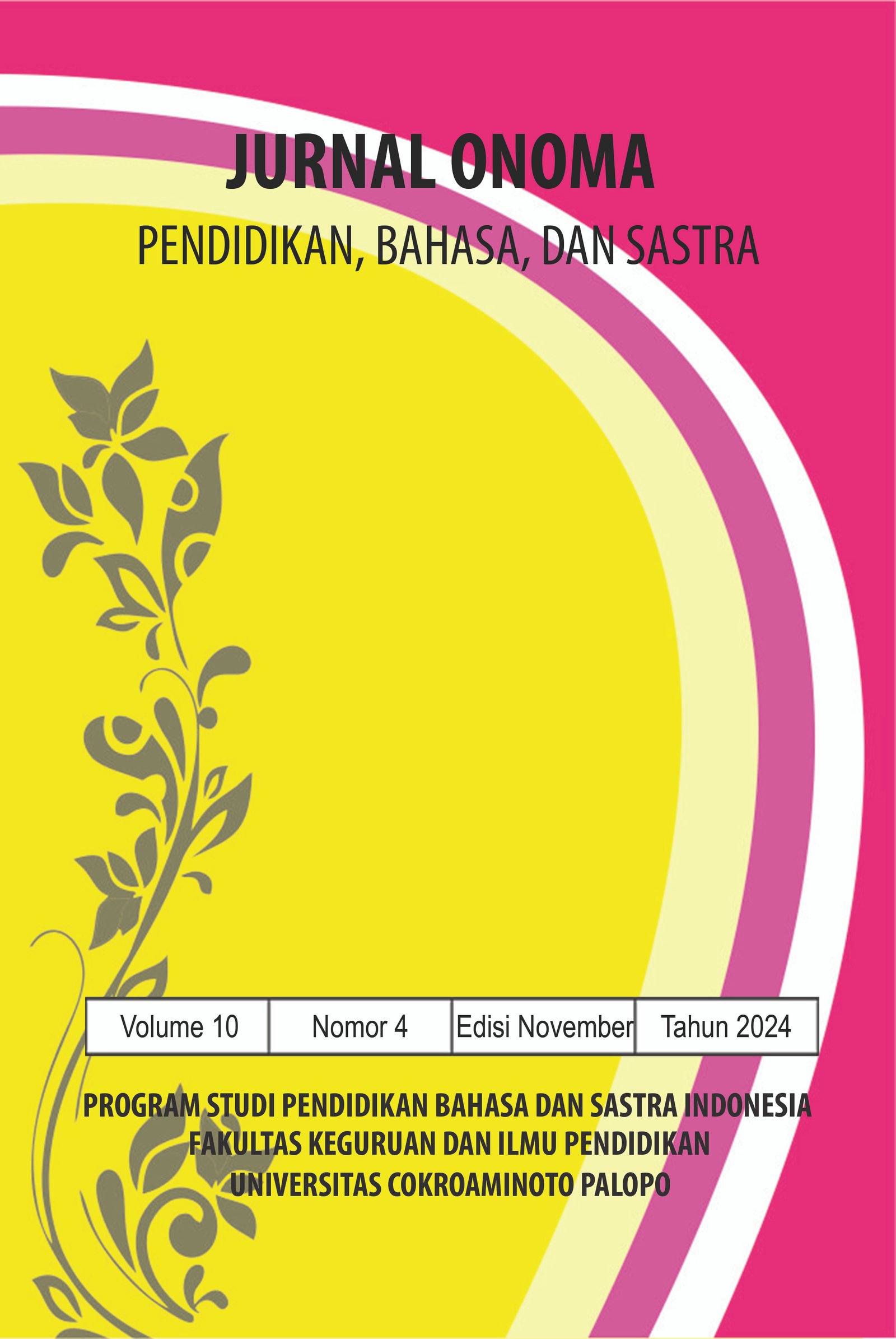Analisis Kebutuhan Materi Ajar Bahasa Indonesia Berbasis Kearifan Lokal bagi TKA di Sulawesi Tengah
https://doi.org/10.30605/onoma.v10i4.4531
Keywords:
Materi ajar, Bahasa Indonesia, Tenaga Kerja Asing, Kearifan lokalAbstract
Penelitian ini bertujuan untuk menganalisis kebutuhan materi ajar Bahasa Indonesia berbasis kearifan lokal bagi Tenaga Kerja Asing (TKA) di Sulawesi Tengah. Perbedaan budaya antara negara asal TKA dan budaya lokal sering menimbulkan kesalahpahaman dan gegar budaya yang dapat mempengaruhi produktivitas dan hubungan kerja sehingga penting pemahaman bahasa dan budaya. Penelitian ini menggunakan metode deskriptif kualitatif dengan teknik purposive sampling dan melibatkan 50 TKA dari tiga perusahaan asing di Sulawesi Tengah. Data dikumpulkan melalui kuesioner. Hasil penelitian menunjukkan bahwa TKA membutuhkan materi ajar yang tidak hanya mengajarkan bahasa tetapi juga memperkenalkan kearifan lokal. Sebagian besar responden menyatakan bahwa pemahaman terhadap kearifan lokal sangat penting dan dapat meningkatkan efektivitas komunikasi serta hubungan kerja di lingkungan baru. Penelitian ini merekomendasikan pengembangan materi ajar yang mencakup komponen budaya lokal secara mendalam untuk meminimalisasi kesalahpahaman dan meningkatkan adaptasi TKA di Sulawesi Tengah.
Downloads
References
Asrianti, A., & Widianto, E. (2019). Mora’akeke Ceremony as a Local Indigenous Material in Indonesian for Speakers of Other Language Class: An Autoethnography studies in Palu, Central Sulawesi. Proceedings of the Proceeding of the 2nd International Conference Education Culture and Technology, ICONECT 2019, 20-21 August 2019, Kudus, Indonesia. https://doi.org/10.4108/eai.20-8-2019.2288125 DOI: https://doi.org/10.4108/eai.20-8-2019.2288125
Baker, W. (2024). Intercultural communication. ELT Journal, 78(2), 212–215. DOI: https://doi.org/10.1093/elt/ccad040
Caldwell-Harris, C. L., & MacWhinney, B. (2023). Age effects in second language acquisition: Expanding the emergentist account. Brain and Language, 241, 105269. https://doi.org/10.1016/j.bandl.2023.105269 DOI: https://doi.org/10.1016/j.bandl.2023.105269
Gudykunst, W. B. (2003). Cross-cultural and intercultural communication. Sage.
Guirdham, M., & Guirdham, O. (2017). Communicating Across Cultures at Work. Bloomsbury Publishing. https://books.google.co.id/books?id=sxtHEAAAQBAJ DOI: https://doi.org/10.1057/978-1-137-52637-3
Hinner, M. B. (2017). Intercultural misunderstandings: Causes and solutions. Russian Journal of Linguistics, 21(4), 885–909. DOI: https://doi.org/10.22363/2312-9182-2017-21-4-885-909
Hossain, K. I. (2024). Reviewing the role of culture in English language learning: Challenges and opportunities for educators. Social Sciences & Humanities Open, 9, 100781. https://doi.org/10.1016/j.ssaho.2023.100781 DOI: https://doi.org/10.1016/j.ssaho.2023.100781
Jafarov, S., & Aliyev, Y. (2024). What causes culture shock? South Florida Journal of Development, 5(7), e4106–e4106. DOI: https://doi.org/10.46932/sfjdv5n7-012
Suparman, S., Herdiana, B., & Nuruahmad, M. (2024). Kemampuan Menulis Karangan Argumentasi Dengan Menggunkaan Media Gambar Pada Siswa Kelas VII SMP NegrI II Walenrang. Jurnal Vokatif: Pendidikan Bahasa, Kebahasaan, dan Sastra, 1(2), 102-108. DOI: https://doi.org/10.51574/vokatif.v1i2.1736
Kaniyazova, A. (2024). INTERCULTURAL COMMUNICATION AND MISUNDERSTANDINGS IN PRAGMATICS. Евразийский Журнал Академических Исследований, 4(4), 87–90.
Sharifian, F. (Ed.). (2014). The Routledge Handbook of Language and Culture (0 ed.). Routledge. https://doi.org/10.4324/9781315793993 DOI: https://doi.org/10.4324/9781315793993
Shin, M.-H., & Lee, E. (2012). The importance of learning language and culture integration: Focused on TOEIC reading comprehension. English Language & Literature Teaching, 18(3), 207–221.
Suyitno, I., Susanto, G., Kamal, M., & Fawzi, A. (2018). Cognitive Learning Strategy of BIPA Students in Learning the Indonesian Language. IAFOR Journal of Language Learning, 3(2). https://doi.org/10.22492/ijll.3.2.08 DOI: https://doi.org/10.22492/ijll.3.2.08
Ting-Toomey, S., & Dorjee, T. (2018). Communicating across cultures. Guilford Publications.
Downloads
Published
How to Cite
License
In submitting the manuscript to the journal, the authors certify that:
- They are authorized by their co-authors to enter into these arrangements.
- The work described has not been formally published before, except in the form of an abstract or as part of a published lecture, review, thesis, or overlay journal.
- That it is not under consideration for publication elsewhere,
- That its publication has been approved by all the author(s) and by the responsible authorities – tacitly or explicitly – of the institutes where the work has been carried out.
- They secure the right to reproduce any material that has already been published or copyrighted elsewhere.
- They agree to the following license and copyright agreement.
License and Copyright Agreement
Authors who publish with Onoma Journal: Education, Languages??, and Literature agree to the following terms:
- Authors retain copyright and grant the journal right of first publication with the work simultaneously licensed under Creative Commons Attribution License (CC BY 4.0) that allows others to share the work with an acknowledgment of the work's authorship and initial publication in this journal.
- Authors are able to enter into separate, additional contractual arrangements for the non-exclusive distribution of the journal's published version of the work (e.g., post it to an institutional repository or publish it in a book), with an acknowledgment of its initial publication in this journal.
- Authors are permitted and encouraged to post their work online (e.g., in institutional repositories or on their website) prior to and during the submission process, as it can lead to productive exchanges, as well as earlier and greater citation of published work.

















